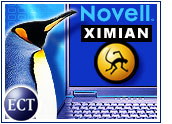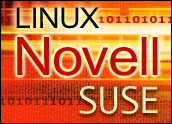
Thirteen years of open collaboration. Thousands of the best minds in software engineering working together worldwide. A unifying conviction that the best ideas emerge from cooperation and peer review. Put it all together, and you have today’s Linux operating system, which is growing at a rapid pace.
As one of the industry’s most robust and stable platforms, the open-source Linux environment lets administrators choose what to deploy and where while lowering software, hardware, and administration costs. With a worldwide community cooperating to fix vulnerabilities, Linux also offers great security. All of these benefits contribute to a low total cost of ownership.
So, why hasn’t everyone already migrated? There are many potential barriers: Lack of internal skills and external support. Concern over disruption of business and IT processes. Resistance to change. Fear. Uncertainty. Doubt. And historically, no major player in the global IT marketplace has been willing and able to address these issues.
Now, with its acquisitions of Ximian and SuSE Linux and its development of Nterprise Linux Services, Novell has taken on the challenge of creating enterprise-class solutions, consulting services, documentation, and support for the Linux world, so organizations can adopt open-source Linux from the desktop to the data center with complete confidence.
Eating Its Own Dog Food
Novell is not simply trumpeting the benefits of Linux to clients. To prove the enterprise Linux concept, the company is adopting Linux as a preferred platform for its own data center and end-user desktops. On the desktop, Novell is already migrating its 5,000-plus employees to the OpenOffice.org office productivity suite running on Microsoft Windows — a stepping-stone to full-scale Linux desktops. The company also is migrating its data-center applications and ultimately expects to move more than 200 desktop and server applications to Linux.
Through this fast-track migration, Novell has developed best practices that can help any organization move successfully from Windows to Linux. Here are a few steps the company has taken so far — and the lessons learned.
1. Plan the Migration Strategy Up-Front
Proactive planning is the antidote to fear and resistance. Novell began its migration plan by documenting critical business processes, categorizing users, identifying “must-have” applications, and choosing the best opportunities for early success.
For example, because OpenOffice.org runs on both Microsoft Windows and Linux, it was chosen as the first application suite for migration. Migration planners had a clear mandate to address issues of user training, application functionality, and document conversion to achieve the quickest time-to-value.
Likewise, it was no accident that Novell’s first Linux desktops were rolled out in the Information Systems and Technology (IS&T) department. By leveraging the expertise of IS&T’s many early adopters in departmental groups around the world, migration planners solved problems early while creating a showcase for success.
2. Document Learning and Progress
All too often, business and technology processes are filed away in individual minds rather than documented explicitly, leading to disagreement, forgetfulness, and endless reinvention. A centralized clearinghouse for knowledge enables better decision-making and faster implementation based on the collective wisdom of the organization.
Following this principle, to create an effective migration roadmap, Novell created tools to capture all business processes, applications and issues. With this knowledge structure in place, departmental teams could assess their needs, evaluate their progress and pave the way for other organizations to follow in their footsteps.
3. Evaluate Applications for Migration Potential
Novell’s planners used a three-stage assessment to determine the best migration path for individual applications:
- Is there a Linux version of the existing application? In many cases, the answer is yes. For example, OpenOffice.org provides the productivity applications that most people need every day. Novell iFolder, iPrint, GroupWise, and other Novell desktop clients all run on Linux. Novell Nterprise Linux Services provides the back-end networking functionality that Novell NetWare is known for, running natively on Linux servers. These and other Linux-native applications offer the simplest migration solution.
- If not, is there a native application with the required functionality? When existing applications don’t run on Linux, a growing number of third-party applications can provide a solid alternative. For example, most users are discovering it is relatively easy to move from Microsoft Windows to Ximian Desktop.
- If even that is not possible, is there a viable interim solution?CodeWeavers CrossOver Office can be used to run Microsoft-native applications on a Linux machine. Some users also may choose a dual-boot system that lets them switch back and forth until they feel comfortable running only Linux.
4. Prioritize Application Rollouts
For each application and user role, Novell evaluated the ease of migration alongside the cost and expected value. For example, in the data center, motivation to migrate tends to be high because Linux gives IS&T staff complete control. Core services, such as Web, file, print and firewall, can be moved to Linux with virtually no end-user impact. With immediate payback in greater uptime and lower licensing fees, migrating these core services first was a no-brainer.
On the desktop, however, migration planners must factor in the costs of transitioning and training employees. Early successes can help users become knowledgeable and excited about Linux. Ximian Desktop and OpenOffice.org are easy to use, provide all needed functions and can save files in Microsoft-, Sun- and Macintosh-compatible formats, so users can work seamlessly with customers and partners. Users must climb a short learning curve before achieving full productivity, but these growing pains are minor, considering that Novell will save nearly US$900,000 per year in Microsoft licensing fees. Again, a no-brainer.
5. Verify and Refine
Novell continues to check plans versus results to ensure it stays on track with its projections throughout the migration process. When ongoing tests show that a new application, business process or training regimen isn’t going to work, planners adjust the migration strategy and move on.
6. Deploy with Confidence
After laying the groundwork in steps one through five, actual implementation becomes the easiest part of the migration. By taking the lead with its own Linux migration, Novell has designed proven processes that can help any enterprise quickly become a successful member of the Linux community.
Debra Anderson is the chief information officer of Novell.













































Social Media
See all Social Media